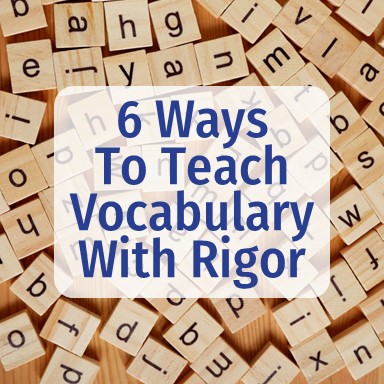
6 Science Vocabulary Activities
Early in my career (late 1990s!), seasoned science teachers did very old-school science vocabulary activities. These lessons were dull, rote, and simply not worthwhile.
But my mentor, Sue, was ahead of the curve. She taught me many ways to make vocabulary lessons both engaging and rigorous. Her science vocabulary lessons held kids’ interest, had them up and moving around the room, and were highly effective. Most importantly, students really, truly understood the meanings of the vocabulary words and how they fit into the “bigger picture” of the unit.
These science vocabulary activities push kids to work with important terms on a much deeper level than memorizing a definition. Let me share with you the science vocabulary activities that she taught me!
Word/Phrase Sorts
This idea is so simple yet so effective.
My go-to way to have students interact with vocabulary is word/phrase sorts. You take two or three of the most key terms of the unit and brainstorm a bunch of words or terms associated with each. Students make a simple T-chart (with 2-3 columns, depending on your main words) and write the keywords at the top of each column. Then, they classify each word or phrase you’ve given them into the appropriate column.
But this is one of those things that’s way easier to understand when you see it.
So, I invite you to download my FREE vocabulary sort for cell energy or my FREE vocabulary word sort for my Earth’s seasons unit. You’ll see more clearly what I’m trying to describe here.
Sentences (not what you think…)
I’m sure you can still hear your 7th-grade English teacher saying, “Now, use this word in a sentence.”
This isn’t that.
Yes, students will have to create sentences using key science vocabulary words, but the important difference is that they must use more than one word in the sentence. As the teacher, you give them the words that they must use together. This forces them to think beyond restating a definition.
For instance, in my unit on Earth’s seasons, I have the students write a sentence using the words axis and revolve. An example sentence they might come up with is, “The Earth rotates on its axis as it revolves around the Sun.”
Or I might give them the terms axis and equinox. A good sentence for this would be, “The Earth experiences an equinox when the Earth’s axis is neither tilted towards or away from the Sun.”
For more examples like this from a seasons unit, download my FREE Seasons Vocabulary Worksheet.

To add even more of a challenge, have kids put three words together in a sentence. In my energy unit, I have the kids use the terms transform, electrical, and mechanical. They might write the sentence, “A clock transforms electrical energy into mechanical energy.” Of course, you would provide many of these combinations.
Heads up: This is very challenging for the students! But I love this activity because it forces kids to see the relationships between words. They demonstrate that they understand the vocabulary word in context.
Carousel Activity
My favorite way to review vocabulary before a test is a carousel activity. Simply pick the most important words/phrases for the unit (maybe 8-10) and write them at the top of their own poster paper (one vocabulary term per paper). Then, put students into pairs or groups. Have the groups circulate through the posters. Every group has to write something about the vocabulary word at the top of the poster, but without repeating anything a group before them said. As the posters get more and more filled, the activity gets more and more challenging! At the end of class, have a whole-class discussion where each group explains the last poster they’ve landed on.

Concept Maps
Concept maps are graphic organizers that help students explore the relationships between the scientific terms in a unit.
This is especially helpful when terms can be organized into categories. I find that a concept map is often the “lightbulb moment” kids need during units with many words.
For instance, in a human body unit, the concept map should have a section for each body system. Then, each section has words associated with that particular body system. Without a visual like this, it’s easy for kids to get lost in a word soup.

I also like to use concept maps to help students put words into perspective with each other, showing how the terms affect each other. For instance, in my seasons concept map, students would fill in the blanks to write, “Earth moves or revolves in its orbit around the sun.”

Kids have to truly understand the meanings of the words and how they fit into the unit as a whole to be able to complete a concept map. This makes this activity far more rigorous than simply writing out definitions.
Bonus: I also like word maps because they are so simple to differentiate! You can easily make several versions, each with an increasing number of “hints” in each box.
Check out what I mean by a “concept map” by downloading my FREE Seasons Vocabulary Worksheet.
Vocabulary Chains
I have seen this used pretty widely, and for good reason – kids really get into them!
And while I don’t think that vocabulary chains are particularly rigorous – they still only require memorization of a definition – anything that gets kids interacting with the vocabulary is a win.
A vocabulary chain is just that. It starts with a set of cards. Each card has a keyword and an unrelated definition on it. The definition on one card will match the keyword on a different card. When the correct term is put end-to-end with the correct definition, it forms a chain.
This is another one of those things you kinda have to see! You can check out my FREE Energy Vocabulary Chain here to see an up-close example of a vocabulary chain.

Before I leave this one… here’s a little tip: Put the chain cards in sandwich baggies and reuse them class-to-class and year-to-year. I copy them on colored paper to distinguish them from other random papers on kids’ desks so they don’t get lost.
The Root of Science Vocabulary Activities
Of course, the best way to get kids really really fluent with science vocabulary words is to teach them how to decode them.
While not too many kids learn Latin or Greek anymore, doing some basic activities with root words, prefixes, and suffixes can go a long way. The more kids work with word parts like exo-, endo-, hetero-, therm-, photo-. (you get the idea), the better.
I developed a brief lesson that introduces students to exactly how science vocabulary words get built, and it’s totally free for my readers. This Building Science Words Worksheet has a small background section with background information about prefixes, suffixes, and root words in science. And it gives students a little bit of practice with them. It’s FREE, so I hope you check it out!
Let’s Connect!
If you like these ideas, please follow me on Instagram where I offer science teacher tricks and tips! And you can follow me on Teachers Pay Teachers, too!
Share it:
- Read more about: Scientific Processes








